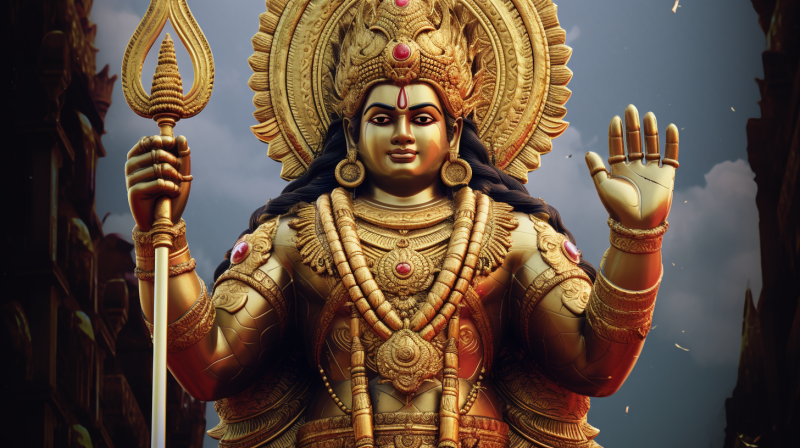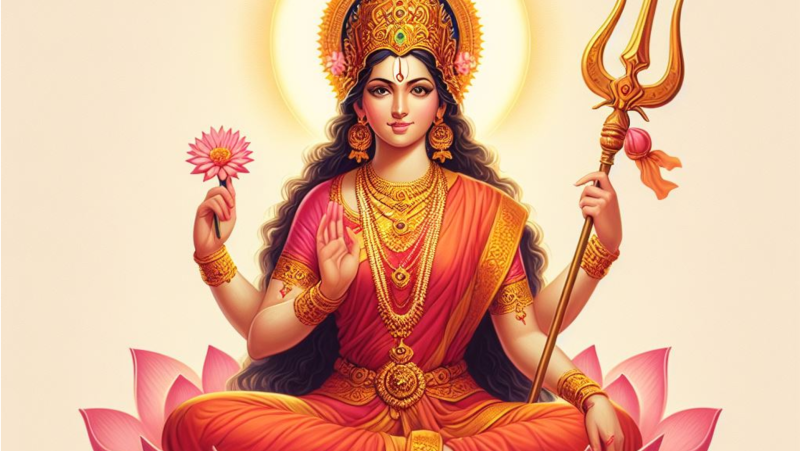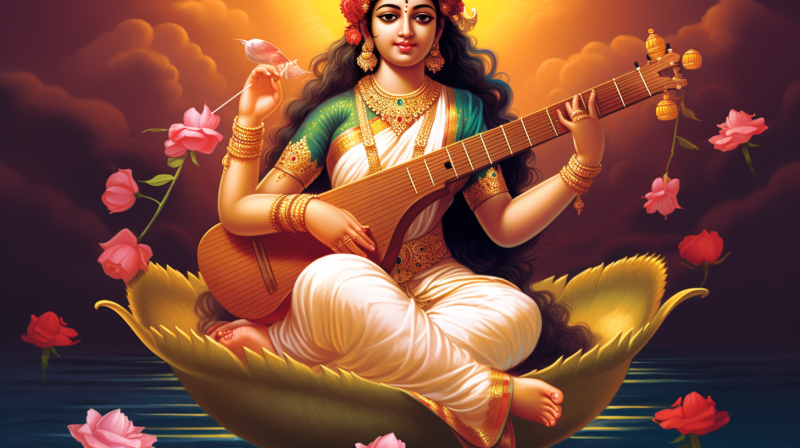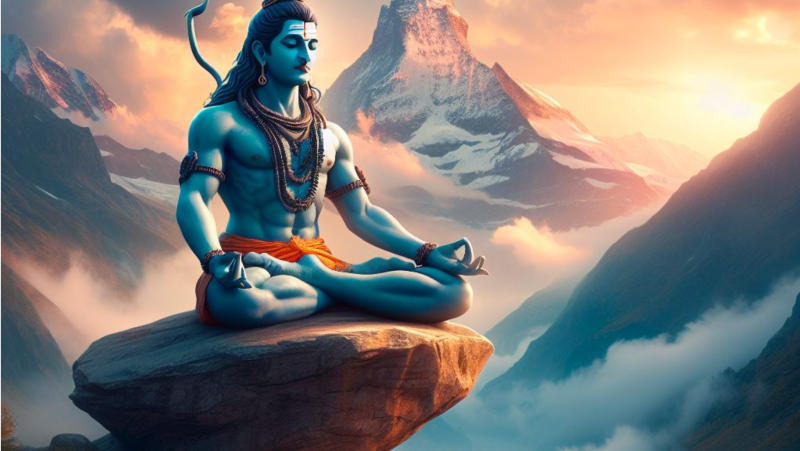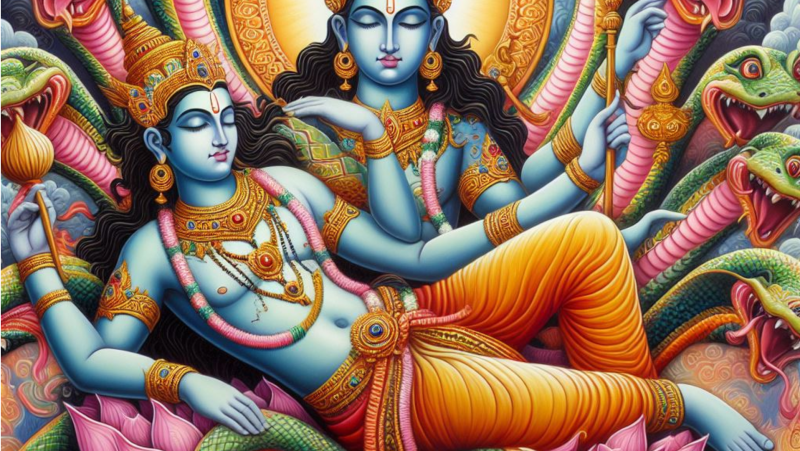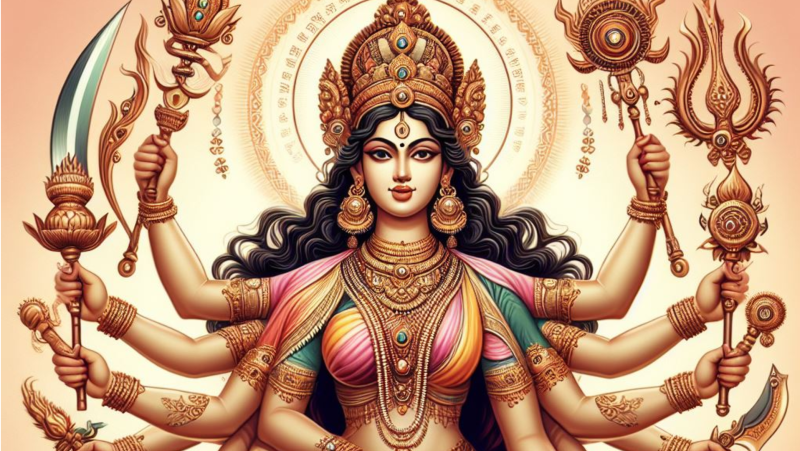
Shakti, in Hinduism, represents the divine feminine energy and is often referred to as the primordial cosmic energy. The term "Shakti" is derived from the Sanskrit word meaning "power" or "energy." She is considered the dynamic force that drives the universe, and her manifestations are revered in various forms and names across Hindu mythology.
Origins and Mythology About Goddess Shakti
The origins and mythology surrounding Goddess Shakti are deeply rooted in Hindu scriptures and mythology. Her manifestation and significance are often associated with various tales and narratives across different texts. Here are some key aspects of her origins and mythology:
1. Creation Mythology: According to Hindu mythology, at the beginning of time, there was only existence in the form of a cosmic male energy known as Shiva or the pure consciousness. This masculine principle lacked action or dynamism. To bring balance and enable creation, this static energy needed a dynamic force. Shakti emerged as the embodiment of this dynamic energy or power.
2. The Union of Shiva and Shakti: The union of Shiva and Shakti is a significant aspect of Hindu philosophy and mythology. Shakti is often considered the consort or divine counterpart of Shiva. The union of these two forces symbolizes the merging of the masculine and feminine energies, representing creation, preservation, and destruction—the essential forces driving the universe.
About Forms and Manifestations of Goddess Shakti
Goddess Shakti, manifests in various forms, each representing different aspects of cosmic power, strength, and divinity. Here are some prominent forms and manifestations of Goddess Shakti:
1. Durga: Durga is one of the most revered forms of Shakti. She symbolizes the warrior aspect of the divine feminine, representing courage, protection, and the triumph of good over evil. Durga is depicted riding a lion or tiger and is worshiped during Navaratri, a festival that celebrates her victory over the buffalo demon Mahishasura.
2. Kali: Kali is a fierce and formidable form of Shakti, associated with destruction and transformation. She is often depicted with a dark complexion, a garland of skulls, and a protruding tongue, signifying her role in annihilating negativity and ignorance. Kali's worship involves seeking liberation from ego and attachment.
3. Parvati: Parvati represents the nurturing and motherly aspect of Shakti. She is the consort of Lord Shiva and is depicted as a gentle, caring goddess. Parvati symbolizes love, fertility, devotion, and the ideal wife and mother. She is also known by various other names such as Uma, Gauri, and Shakti.
4. Lakshmi: Lakshmi is the goddess of wealth, prosperity, and abundance. She signifies material and spiritual prosperity, good fortune, and well-being. Lakshmi is worshipped during Diwali, the festival of lights, to invite wealth and prosperity into homes and businesses.
5. Saraswati: Saraswati is the goddess of knowledge, wisdom, arts, and learning. She embodies creativity, music, literature, and intellect. Saraswati is depicted with a veena (musical instrument) and symbolizes the pursuit of knowledge and enlightenment.
6. Tripura Sundari: Also known as Lalita, Tripura Sundari represents beauty, grace, and divine charm. She is worshiped for spiritual upliftment and harmony. Her name translates to "The Beautiful Goddess of the Three Worlds."
7. Bhuvaneshwari: Bhuvaneshwari symbolizes the universe and is associated with cosmic energy. She embodies the creation and nurturing of the world and is worshiped for stability, abundance, and sustenance.
8. Chandi or Chandika: Chandi is a fierce form of Shakti often depicted as a warrior goddess. Her legends are described in texts like Devi Mahatmya (Durga Saptashati), where she battles and defeats various demons, symbolizing the triumph of good over evil.
These are some of the major forms and manifestations of Goddess Shakti, each revered for specific qualities and worshipped by devotees seeking various blessings, strengths, and aspects of divinity in their lives. Each form represents a facet of the universal cosmic energy that governs and sustains the universe.
About Goddess Shakti Symbolism
Goddess Shakti, is symbolized in various ways across different forms and manifestations. The symbolism associated with Shakti represents her attributes, powers, and significance within Hindu cosmology. Here are key aspects of Goddess Shakti's symbolism:
1. Multiple Arms and Weapons: Shakti is often depicted with multiple arms, each carrying various weapons or symbolic items. These arms symbolize her immense power, strength, and ability to protect devotees from all directions. The weapons held in her hands signify different aspects of her authority over cosmic forces. For example:
• The trishul (trident) symbolizes control over past, present, and future.
• The sword represents knowledge and the ability to cut through ignorance.
• The conch shell signifies the primordial sound of creation.
• The discus symbolizes the wheel of time and cosmic order.
2. Mount or Vehicle: Goddess Shakti is associated with specific mounts or vehicles that carry symbolic meaning. For instance:
• Durga is often depicted riding a lion or tiger, symbolizing power, courage, and fearlessness.
• Parvati is associated with riding a lion or sometimes a bull, signifying her strength and control over primal instincts.
• Kali is sometimes depicted standing on Lord Shiva, representing the ultimate union of Shiva and Shakti.
3. Divine Consort: Shakti is portrayed as the divine consort or feminine counterpart to various male deities, particularly Lord Shiva, Vishnu, or Brahma. This symbolism emphasizes the inseparable relationship between masculine and feminine energies, signifying the balance and interdependence required for creation and sustenance.
4. Cosmic Energy and Creation: Shakti embodies the cosmic energy that drives creation, preservation, and destruction. Her symbolism represents the dynamic and transformative force in the universe, signifying the cycle of birth, life, and death.
5. Goddess with Various Attributes: Depending on the form, each aspect of Shakti carries specific attributes that symbolize different aspects of life:
• Lakshmi holds symbols of wealth and prosperity, such as the lotus flower and gold coins.
• Saraswati is depicted holding a veena (musical instrument) and a book, symbolizing knowledge and arts.
• Durga's fierce appearance, riding a lion and wielding weapons, symbolizes protection and courage.
6. Divine Motherhood: Several forms of Shakti, like Parvati and Durga, are depicted as mothers, emphasizing the nurturing, caring, and protective nature of the divine feminine.
7. Feminine Power and Empowerment: Shakti's symbolism embodies the power and strength inherent in femininity. She represents empowerment, independence, and the ability to overcome obstacles.
The symbolism associated with Goddess Shakti reflects the diverse aspects of cosmic energy, divine femininity, strength, and protection that she represents in Hindu mythology and philosophy.
About Goddess Shakti Importance
Goddess Shakti holds immense importance in Hinduism, embodying the divine feminine energy that symbolizes power, creativity, and the dynamic force sustaining the universe. Her significance pervades various aspects of Hindu philosophy, spirituality, rituals, and daily life. Here's an in-depth look at the importance of Goddess Shakti:
1. Creator and Sustainer: Shakti represents the creative force of the universe. She is believed to be the primal energy responsible for creation, preservation, and dissolution. Shakti's dynamic nature sustains the cosmic order, and her power is considered fundamental to maintaining equilibrium in the cosmos.
2. Balance and Harmony: Hindu philosophy emphasizes the balance between masculine (Shiva) and feminine (Shakti) energies. Shakti's importance lies in her role as the complementing force to Shiva, highlighting the interconnectedness and necessity of both energies for cosmic balance and harmony.
3. Goddess of Strength and Protection: Shakti embodies strength, courage, and protection. Forms like Durga and Kali showcase her warrior aspect, symbolizing the ability to overcome obstacles, fight evil forces, and protect devotees from harm or negativity.
4. Nurturer and Motherly Figure: Goddesses like Parvati depict Shakti's nurturing and motherly attributes. She represents love, compassion, fertility, and the ideal mother figure, nurturing and caring for all beings.
5. Spiritual Growth and Enlightenment: Shakti is central to various spiritual practices, especially in Tantra and Shakta traditions. Devotees seek her blessings for spiritual growth, transformation, and self-realization. These practices involve rituals, meditation, and mantra chanting to awaken the divine feminine within oneself.
6. Symbol of Feminine Power: Shakti symbolizes the inherent power and potential present within every individual, irrespective of gender. Her significance extends beyond religious contexts to serve as a symbol of women's empowerment, strength, and resilience.
7. Cultural Celebrations and Festivals: Several Hindu festivals, such as Navaratri, Durga Puja, and Kali Puja, celebrate different forms of Shakti. During these festivals, devotees worship and pay homage to Goddess Shakti, seeking her blessings for various aspects of life like prosperity, wisdom, protection, and inner strength.
8. Source of Knowledge and Creativity: Goddess Saraswati, a form of Shakti, represents knowledge, arts, music, and creativity. She symbolizes the pursuit of wisdom, learning, and the source of inspiration for artists and scholars.
9. Unity in Diversity: Shakti is worshiped in various forms and names across regions and cultures within Hinduism. This diversity showcases the multifaceted nature of divine energy and how devotees relate to her in different aspects of life.
Goddess Shakti's importance extends far and wide, serving as a source of inspiration, strength, protection, and spiritual elevation for millions of devotees, and emphasizing the profound significance of the divine feminine in Hindu spirituality and culture.
About Goddess Shakti Festivals and Worship
Goddess Shakti is worshiped fervently in various festivals across India and other parts of the world where Hinduism is practiced. These festivals celebrate the diverse forms and manifestations of Shakti, each representing different aspects of divine feminine energy. Here are some prominent festivals dedicated to Goddess Shakti:
1. Navaratri: Navaratri, meaning "nine nights," is one of the most significant festivals dedicated to Goddess Shakti. Celebrated over nine nights and ten days, it honors the various forms of the goddess. Each day is dedicated to worshiping a different manifestation of Shakti, such as Durga, Lakshmi, and Saraswati. Devotees perform rituals, recite prayers, conduct elaborate ceremonies, and participate in dance forms like Garba and Dandiya Raas in some regions. Navaratri culminates with Vijayadashami, marking the victory of good over evil.
2. Durga Puja: Durga Puja is a grand celebration primarily observed in the eastern part of India, especially in West Bengal. It commemorates the victory of Goddess Durga over the demon Mahishasura. Elaborate pandals (temporary structures) are created, showcasing artistic renditions of Durga idols. The festival involves colorful processions, traditional music, dance, and cultural performances.
3. Kali Puja: Kali Puja is dedicated to worshiping Goddess Kali, who represents destruction and creation. Celebrated primarily in West Bengal, Odisha, and other parts of eastern India, it occurs on the night of the new moon in the Hindu month of Kartik. Devotees perform rituals, offer prayers, and conduct special ceremonies to honor Goddess Kali.
4. Lalitha Panchami: This festival commemorates Goddess Lalita Tripura Sundari, representing beauty and grace. It is observed by worshipping the goddess, seeking her blessings for happiness and well-being. Lalitha Panchami is celebrated on the fifth day (Panchami) during Navaratri in some regions.
5. Vasant Navaratri: Also known as Chaitra Navaratri, this festival occurs in the Hindu month of Chaitra (March-April). It honors the nine forms of Goddess Shakti, particularly in North India. Devotees fast, perform rituals, recite prayers, and seek blessings during this auspicious period.
6. Shakti Peethas Pilgrimage: Several pilgrimage sites across the Indian subcontinent are believed to be Shakti Peethas, places where body parts of Goddess Sati (an incarnation of Shakti) fell when Lord Shiva danced in sorrow carrying her burnt body. Devotees visit these sites to seek blessings and pay homage to the divine feminine.
During these festivals, devotees engage in various forms of worship, including offering prayers, performing aartis (rituals with lighted lamps), chanting hymns and mantras, conducting special ceremonies, fasting, and participating in cultural events to honor and seek the blessings of Goddess Shakti in her different manifestations.
About Goddess Shakti Philosophical Significance
Goddess Shakti holds profound philosophical significance within Hinduism, particularly in relation to metaphysics, spirituality, and cosmology. Her philosophical importance is deeply rooted in several key aspects:
1. Principle of Creation and Energy: Shakti represents the divine, primordial cosmic energy that underlies the entire universe. She embodies the dynamic force responsible for creation, preservation, and destruction. This energy is seen as the fundamental power that drives the cycles of existence and sustains cosmic order.
2. Interconnectedness and Balance: Hindu philosophy often emphasizes the balance between masculine (Shiva) and feminine (Shakti) energies. Shakti's significance lies in her complementary relationship with Shiva, signifying the interdependence and inseparability of these cosmic forces. The union of Shiva and Shakti represents the harmony and equilibrium necessary for creation and cosmic balance.
3. Tantric Traditions: Shakti holds a central position in Tantric practices, where the focus is on harnessing and awakening the dormant divine energy within individuals. Tantra emphasizes the worship and integration of Shakti through rituals, meditation, and specific practices to achieve spiritual transformation and enlightenment.
4. The Concept of Kundalini: In Kundalini Yoga, a philosophical and spiritual system, Shakti is represented as Kundalini, a coiled serpent power residing at the base of the spine. The practice involves awakening this dormant energy through yogic techniques to ascend through the chakras, leading to spiritual awakening and enlightenment.
5. Three Gunas and Divine Feminine: In Hindu philosophy, the cosmic energies are often categorized into three gunas (qualities): Sattva (purity), Rajas (activity), and Tamas (inertia). Shakti represents the Sattva Guna, signifying purity, balance, and illumination. She is the embodiment of divine femininity and the creative aspect of these gunas.
6. Shaktism and Shakta Philosophy: Shaktism, a sect within Hinduism, reveres Shakti as the supreme deity. It emphasizes the worship of the divine feminine in various forms and holds philosophical teachings that emphasize the power of Shakti in creation, existence, and spiritual liberation.
7. Unity in Diversity: Shakti's philosophical significance transcends individual forms and names. It showcases the diversity and multiplicity of the divine feminine energy, teaching that although the forms may vary, they all represent the same underlying cosmic force.
Goddess Shakti's philosophical significance delves into the fundamental aspects of creation, energy, spirituality, and the interplay of cosmic forces, offering a rich and multifaceted understanding of the divine feminine in Hindu metaphysics and spiritual practices.
About Goddess Shakti As Symbol of Empowerment
Goddess Shakti is revered as a symbol of empowerment, representing the strength, resilience, and inherent power present within every individual. Her symbolism as a figure of empowerment is prominent in various aspects:
1. Feminine Power: Shakti embodies the divine feminine energy, representing the potency and strength of femininity. Her depiction as a goddess with multiple arms, holding weapons, and riding fierce creatures symbolizes her empowerment, fearlessness, and ability to overcome challenges.
2. Independence and Self-Sufficiency: Shakti is often depicted as an independent deity, not just as a consort to male gods but also as an entity with her own distinct identity and powers. This representation emphasizes self-sufficiency and independence, asserting that women possess innate strength and capabilities.
3. Courage and Fearlessness: Forms like Durga and Kali exemplify courage, fearlessness, and the ability to confront and vanquish evil forces. They serve as role models for individuals facing challenges, encouraging them to confront difficulties with bravery and determination.
4. Nurturing and Protective Nature: Alongside her fierce forms, Shakti's nurturing aspects, such as Parvati or motherly forms of the goddess, symbolize compassion, care, and protective instincts. This representation showcases that empowerment can manifest in various nurturing and caring roles.
5. Equality and Balance: Shakti's significance lies in the balance and complementary nature of masculine and feminine energies. Her depiction alongside male deities underscores the equality and interdependence of both energies, advocating for a harmonious union to achieve balance and empowerment.
6. Spiritual Empowerment: Shakti's worship in various forms emphasizes spiritual growth and enlightenment. Tantric practices associated with Shakti encourage individuals to seek inner strength, transformation, and spiritual awakening through meditation, rituals, and devotion.
7. Cultural and Social Impact: In Hindu culture, festivals like Navaratri and Durga Puja celebrate the empowerment and strength of Goddess Shakti. These celebrations serve as platforms to honor the divine feminine, instilling a sense of empowerment and pride among devotees.
Goddess Shakti's symbolism as a figure of empowerment extends beyond religious contexts to inspire and empower individuals, especially women, highlighting their inherent strength, resilience, and the ability to overcome obstacles in various spheres of life. Her representation as a symbol of empowerment continues to influence cultural perceptions and societal paradigms concerning feminine strength and empowerment.
You may also like …
Are You The Proud Hindu?
The Trimurti
Create an account to join us and start taking part in conversations.
SIGNIN